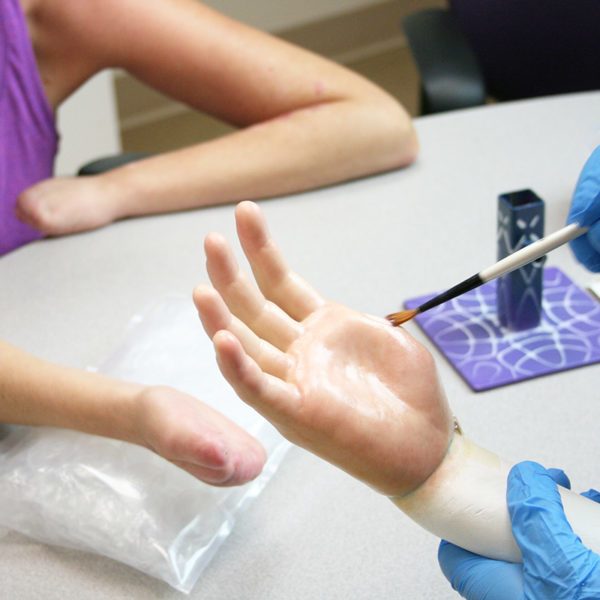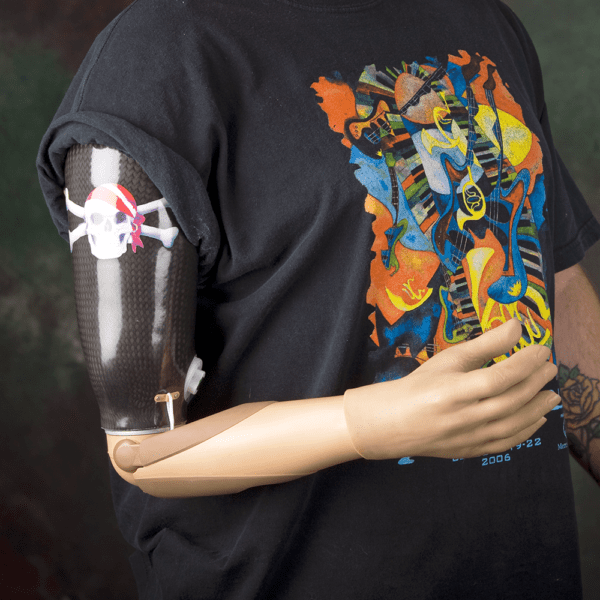UPPER EXTREMITY PROSTHETIC DEVICES
There are approximately 10,000 new upper extremity amputations in the United States every year.
The two most common causes of upper extremity amputations are trauma (cut, tear, burn, freeze) and surgery (performed to remove a diseased or useless part of the body). It has been found that 75% of the upper extremity amputations in adults are caused due to some kind of trauma such as motor vehicle accident, machinery accident, gunshot wound or electrical burns.
Our specialized upper extremity prosthetists have an in-depth understanding of an upper extremity amputee’s unique needs. Having extensive exposure working with a variety of upper extremity amputation levels along with the techniques and technology which help make upper extremity prosthetic users successful, our practitioners provide unparalleled patient experiences and outcomes.
SCROLL DOWN TO VIEW UPPER EXTREMITY PROSTHETIC OPTIONS
Upper Extremity Amputations
There are several different types of upper limb amputations and each type of amputation can impact the type of prosthetic device or prosthetic technology you are a candidate for and ultimately choose/need. An upper limb amputation is the removal of part of the fingers, hand, forearm or arm. An experienced prosthetist may be consulted to establish what amputation level is most favorable for your future prosthetic device. The amputation level factors into what kind of prosthesis is most suitable. Depending on the level of your upper limb amputation (arm, hand, or finger), your ability to use certain prosthetic technologies can vary greatly.
What are the different amputation levels for an upper extremity?

Click on a level below to read more.
Choosing an Upper Extremity Prosthesis
The human arm and hand are complex structures, for each amputation level we often recommend multiple terminal devices or multiple prosthetic devices to meet the individual’s needs. We recommend that each individual chooses the best tool for the job or activity in which they are involved, in order to have the best possible outcomes.
We provide several prosthetic options for upper extremity amputation levels.
Myoelectric / External Power
A myoelectric upper extremity prosthetic device is powered by a battery system and is controlled by electromyography (EMG) signals generated during muscle contractions received through electrodes mounted in the socket. These signals are sent to a motor in the prosthetic elbow and/or wrist. A myoelectric elbow may then bend or straighten, a wrist can flex, and a hand can open or close. There are many different types of myoelectric prostheses produced by various manufacturers. The advantages of a myoelectric prosthesis is that there is an unlimited functional envelope; it offers functional cosmetic restoration; it can increase a person’s grip force to 20-32 lbs; and the harness system is reduced or eliminated, which offers comfort and increased range of motion.

Passive Functional / Cosmetic
A passive functional or cosmetic upper extremity prosthetic device is similar in appearance to the non-affected arm or hand and replaces what was removed. It provides simple aid in balancing and carrying. The advantages of this type of prosthesis is that it can be cosmetically appealing; lightweight; simple to use; there is little maintenance; they are great for partial hands and provides opposition.
Partial Hand and Finger
Finger and partial-hand amputees are among the most common type of prosthetic patients seen. However, it was not until recently that a variety of options became available for these prosthetic devices. Playing an important role for amputees, these prostheses offer gripping options and counter-support when grasping objects.
Adaptive / Recreational
A recreational or adaptive upper extremity prosthetic device is customized for a specific function or recreational activity. There are various adaptive devices available for activities such as skiing, golf, fishing, construction work, shooting pool, playing guitar, gymnastics, and so much more.
WCBL patient, Larry French, demonstrates the uses of various upper extremity prosthetic devices custom designed and fabricated to restore his ability to enjoy a variety of recreational activities.

Hybrid
A hybrid upper extremity prosthetic device combines the use of body power and external power. The advantages of this system are a greater functional envelope from the basic body powered device; reduced weight from the myoelectric device; greater grip force similar to the myoelectric; the harness system is reduced; and the initial costs and maintenance costs are reduced.
Body Powered / Conventional
A body powered or conventional upper extremity prosthetic device is operated by a harness system. The harness system is controlled by specific body movements. The advantages of a conventional prosthesis are the heavy duty construction of the device increases durability; it offers proprioception; it’s less expensive and lighter in weight than myoelectric devices; and there is a reduced cost and maintenance. (NP, M-Fingers)

